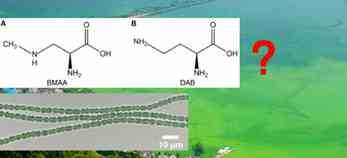Do cyanobacteria make the neurotoxin β-N-methylamino-L-alanine (BMAA)?
Published 12 October, 2023
β-N-methylamino-L-alanine (BMAA), a non-protein amino acid initially discovered in Cycas in 1967, has gained attention for its potential association with neurodegenerative diseases such as amyotrophic lateral sclerosis, Parkinson's and Alzheimer's. Cyanobacteria are thought to be responsible for BMAA production, and a hypothesis suggests it accumulates in the brain tissue of flying foxes and humans through the food chain, possibly contributing to higher neurodegenerative disease rates among Guam's indigenous population. However, controversy surrounds both BMAA production and its role in neurodegenerative diseases due to conflicting data and ongoing disputes over BMAA detection in biological samples, including cyanobacteria. The absence of a standardized detection method compounds the issue, with inconsistent results even from identical methods across different laboratories.
“Believers can detect BMAA in all samples, while non-believers found none and remain skeptical”, says Cheng-Cai Zhang, co-corresponding author of a new study published in Water Biology and Security.
Interestingly, the authors had previously demonstrated the toxicity of BMAA to various cyanobacterial species, a finding that appeared contradictory to these organisms' ability to produce this compound. In their recent study, the researchers created an amino acid transport mutant incapable of absorbing BMAA.
“Using this mutant as a control, we observed that the detection method effectively identified BMAA when cells took up the compound. However, in the absence of externally added BMAA, no signal for BMAA was detectable,” shared Zhang.
This approach served to validate their detection method, demonstrating its sensitivity comparable to that reported in existing literature. However, the team encountered a signal that closely resembled BMAA but was, in fact, identified as DAB, a commonly occurring BMAA isomer.
“When we applied this highly sensitive method to a broad collection of laboratory-cultured strains and natural cyanobacterial bloom samples, none of them yielded detectable levels of BMAA,” said Zhang.
These new findings, in conjunction with BMAA's known toxicity, raises significant doubts regarding its cyanobacterial origin. They also underscore the importance of incorporating single ion chromatograms for distinguishing BMAA from DAB or other isomers in future BMAA research.

Contact author name, affiliation, email address: Prof. Cheng-Cai Zhang, Institute of Hydrobiology, Chinese Academy of Sciences, Wuhan, China. Email: cczhang@ihb.ac.cn
Social media handles: Twitter: @CCZhang_cyano; ResearchGate : https://www.researchgate.net/profile/Cheng-Cai-Zhang
Funder: Funded by the Institute of Hydrobiology, CAS
Conflict of interest: The authors declare that they have no known competing financial interests or personal relationships that could have appeared to influence the work reported in this paper.
See the article: Wang, Z.-Q. et al., Investigation on cyanobacterial production of the proposed neurotoxin β-N-methylamino-L-alanine (BMAA), Water Biology and Security, https://doi.org/10.1016/j.watbs.2023.100208.